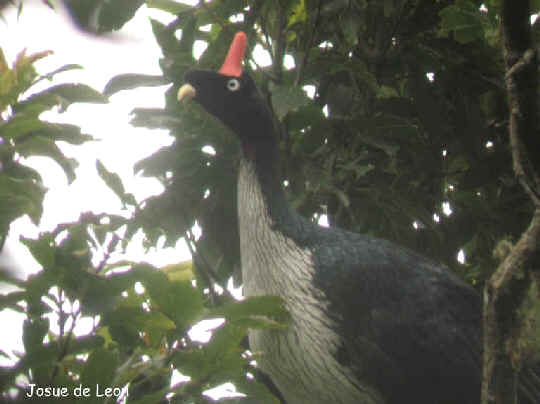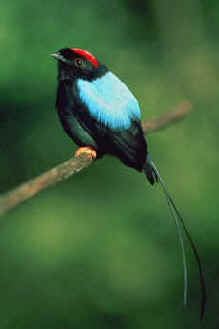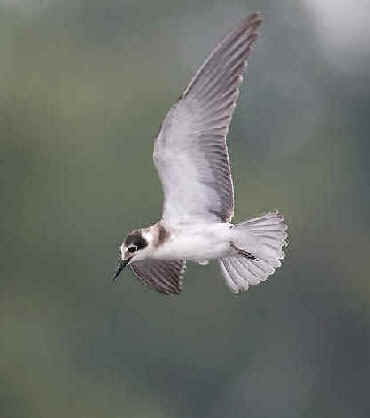
E-mail: font@focusonnature.com
Phone: Toll-free in USA 1-888-721-3555
or 302/529-1876
 |
PO
Box 9021, Wilmington, DE 19809, USA E-mail: font@focusonnature.com Phone: Toll-free in USA 1-888-721-3555 or 302/529-1876 |
THE FOCUS ON NATURE TOUR IN GUATEMALA
July 2007
with
the Horned Guan, many other birds,
& a hatchling Olive Ridley Sea Turtle on the beach

Above: one of
two very rare HORNED GUANS
we saw together on July 17, 2007
during our tour in Guatemala.
(Photo during our tour by Josue de Leon,
one of our guides)
Links:
Birds & Other Wildlife during our Guatemala Tour in July '07
A List of Birds during FONT Guatemala Tours
Upcoming FONT Birding & Nature Tours in Guatemala
![]()
The following narrative of the FONT July '07 Guatemala Tour was written by Armas Hill, leader of the tour:
Our tour in Guatemala, July
14-23, 2007, had some extraordinary moments.
Early in the morning on July 16th, we drove
to Hawaii.
Now, one does not do that every
day (drive to Hawaii that is!).
We had spent the night near there in the
town of Monterrico, on a barrier beach
island by the Pacific Ocean. From where we stayed by the sea, It's about a
20-kilometer drive south to the village of Hawaii, where of course there's also
beach and surf.
And also there is a reserve for sea turtles. From July through December, female Olive
Ridley Sea Turtles come onto the beach at night to dig a hole in which they
deposit their eggs.
When we arrived at the buildings of the reserve early that morning, we were met
by two young "volunteers" (ladies from Germany), who told us
that a female turtle had come to shore the previous night and laid eggs. And so,
we were lucky (even though we had not been there the night before).
In the facility, eggs gathered from turtle nests are put in sand to hatch. That night, a
number of them did - 62.
The turtle hatchlings must go to the sea within 4 hours after they hatch from
the eggs.
There was one ready to go when we arrived. First, we held the little black
creature in our hands. It was about the size of our palms. We stroked its back
before it was put on the beach, where it immediately started to make its way
toward the ocean.
The little turtle then stroked its way along, with its small flippers, closer
and closer to the surf, just as others have for centuries. We saw it for a few
seconds in the water before it disappeared.
If that baby turtle were a male, it would never again come to shore. (There's
no way to know if it was a boy or a girl.) The male sea turtle, after those
few minutes on land, would spend its entire life in the ocean. If that baby
turtle were a female, it would come back onto the beach again, some night in the
future, to dig a hole in which to lay its eggs.
Our visit to the Hawaii Reserve, and our time with the young turtle hatchling,
was, yes, an extraordinary moment.
During the season at Hawaii for the Olive Ridley Turtle, volunteers, such
as those 2 German ladies, monitor and assist the turtles, every day and night,
in their natural process of perpetuating the species.
And so, during the past
few years, thousands of baby sea turtles have made their way into the sea
without predation on land by birds or mammals (including humans).
Back in
2003, on the beach at Hawaii, over 13,000 sea turtle hatchlings
made it into the ocean. In 2006, with the continued efforts of
the volunteers, there were about twice as many as there had been 3 years earlier
- with over 28,000 young turtles stroking their flippers as they did the
walk on the beach to the ocean.
When we walked together with the one hatchling on the beach, that morning in
July 2007, no birds came in close to us to snatch up the little turtle.
Hopefully, once it got into the ocean, it escaped predation as well.
We'll have to go back to that place another time during a future FONT tour, to
again have such an experience, maybe during the December-February season when
the larger Leatherback Sea Turtles come onto that same beach to lay their eggs.
And it won't be hard for us to go back to nearby Monterrico either. We've had
some truly wonderful boat-trips there, during all of our previous visits, in the
vast area of lagoons, marshes, and mangroves between the barrier beach island
and the mainland.
During those boat-trips, we've enjoyed clouds of waterbirds.
In April, for example, many Wood Storks and American White Pelicans
floated on the thermals in the air above the marshes. Also, during an April
visit, we had a close view there of a Guatemalan rarity, the Pinnated Bittern,
a species most commonly in South America. We also saw, during that trip, Boat-billed
Herons, roosting in mangroves near Mangrove Warblers. These were in
addition to hundreds of egrets, herons, and other waterbirds, that
we've seen during all of our tours at Monterrico.
Again, during our July '07 tour, in addition to the waterbirds, there
were Lesser Yellow-headed Vultures drifting above us in the sky.
"New" for us there, during the July '07 tour, were Black Terns.
Throughout the marsh, something that we never encountered there previously was
the continual singing of the Ruddy-breasted Seedeater. In every patch of
reeds, they appeared to be nesting, with the males perched up high, proclaiming
territories in song.
We've referred to our morning on the beach with the sea turtle hatchling as an
extraordinary moment.
Another moment that was extraordinary, for sure, during our July '07 Guatemala tour, was in the
afternoon of July 17th.
It was
when we looked up into the green-leaved canopy of the mountain forest above us
and saw, one of the most spectacular of birds, the Horned Guan!
We had started that day early - very early in fact. We were driven, when it was
still dark, by one of our two guides on the mountain, up to the dirt road until it
ended. Beyond that point, it was a trail that continued to go up - and up.
The area where
we were is truly a wonderful piece of Guatemalan countryside.
The forest on the
slopes of the volcanic mountain is pristine.
During one of our previous
Guatemala tours in that area where the dirt road ends, we saw, during a morning,
3 species of Hawk-Eagles fly overhead: the Black, the Black-and-white,
and the Ornate. That alone says that the area is good for birds, with
forest pristine indeed.
During our July '07 tour, as we arrived at the end of the road, it was
earlier in the morning than during our previous visits. As noted, it was still dark. Actually, there was
well over an hour to go before the first light of dawn.
We looked upward to a brilliant array of stars, in a very clear sky, far away from any
city lights. The "W" of Cassiopeia was bright, and with it, a
background of many stars. The Milky Way, spread across the sky, was
brilliant. In the distance, we heard the call of a Mottled Owl. We had
just seen a Pauraque along the road.
Shortly after we started out on the upward trail, still in darkness, the second
of our two guides pointed to a hole and a mound of loose dirt on the trail. This
was the guide who lives on the mountain, and, we were told, "never left
it".
And, we were told that he knows, better than anyone, the haunts and the habits
of the rare and the (sorry to repeat myself) spectacular Horned Guan.
Anyway, the hole and the mound on the trail, he told us, was the workings of a Puma.
"When it does poo", he said, "the animal covers it up". Yes,
the area where we were was pristine, and wild!
As we walked, when still dark, we flushed a bird from its nest in an arcing
branch by the trail. We soon began to hear some birds, as we experienced a
wonderful dawn chorus - one quite different than what we would hear otherwise,
nearly anywhere else.
The first sound we heard was the beautiful song of the Spotted
Nightingale-Thrush. A short while later, in the distance, we heard the
call-note of the Spotted Wood Quail. It's funny how the two birds named
"spotted" never were - by us. We only heard them.
We did both hear and
see, that day, the Ruddy-capped Nightingale-Thrush. It too has a
beautiful song, as its name implies.
Motmots call early, as they contribute to the dawn chorus. As we
walked, still and ever upward, we heard both the Blue-crowned Motmot (that
occurs in various habitats throughout Guatemala), and the Blue-throated
Motmot (that's only in the high mountains).
There was a nice assortment of Wrens that we heard at dawn, and that we later saw
during daylight:
the Plain, the Gray-breasted Wood, the
Spot-breasted, the Rufous-browed, and the Rufous-and-white.
Among other birds that we saw and heard in the forest that morning was a Mockingbird,
called the Blue-and-white.
In addition to the Nightingale-Thrushes, others in that tribe that we
encountered that morning were the White-throated Thrush and Brown-backed
Solitaire.
The Rufous-browed Peppershrike was vocal, as it tends to be. We also saw
a couple of its cousins that day, the Chestnut-sided Shrike-Vireo, and
then later, in an area of forest on a lower slope, the Green
Shrike-Vireo was present. It, too, was vocal.
In the higher forest, as we still continued upward to where we aimed to see the Horned
Guan, we came across a couple brown birds of the forest, the Ruddy
Foliage-gleaner, close to the ground, and the Scaly-throated
Foliage-gleaner, higher in a tree. Neither stayed in view for long. Nor did
the Black-throated Jay, also up in a tree. Staying around a bit longer
were some Emerald Toucanets.
The Yellowish Flycatcher, an empidonax, was easy to see along our
trail, as were some other birds we encountered as they encountered some ants on
which to feed.
The most-common bird in that flock, drawn to the ants was the aptly-named Common
Bush Tanager. But their supporting cast was pretty good, including the Golden-browed
Warbler (a beauty), the Slate-throated Whitestart (also
dapper, with whatever name - it has been called the Slate-throated
Redstart), and the Tawny-throated Leaftosser, the Rufous-browed
Wren, and the Chestnut-capped Brush Finch.
Also close to us, as we stopped one time for a rest, a brilliant male Violet
Sabrewing, a large hummingbird (yes, very violet), sat on a low tree branch.
A little further away, in the trees, a colorful little bird, good to see,
was the Blue-crowned Chlorophonia.
Larger, and also colorful, was
the Collared Trogon we saw well.
Also with bright red coloration, was the male White-winged
Tanager that we observed in the trees.
All of these birds were, of course, very nice, but we still had not see THE
guan. We had yet seen a guan of any kind. The Highland Guan also
occurs.
The Horned Guan is not the only avian rarity that lives on the Guatemalan
mountain we visited that day. There's another. It's a gem called the Azure-rumped
Tanager. For years, through most of the 20th Century, there were only just a
few records of the bird. It has a limited range, at only a particular elevation,
on the Pacific slope of a
handful of mountains in southern Mexico and northwestern Guatemala. There are
not many of them.
But, luckily, we did encounter the rare species early in the morning, during our hike on the mountain.
A pair had just recently bred in the area. After nesting, these tanagers travel
about with other small forest birds in a group.
The Azure-rumped Tanager was just said to be a gem. And that it is. The
bird is a mix of various blue colorations. One of those hues, the one in the
bird's name, azure, is the color of the rump. The bird's crown is mauve. The
bluish back is mottled with black and has a green tint. The underparts are a
pale blue. The wings have turquoise.
Something else, very blue - a bright blue, was seen during our hike along the
trail. On the ground, we did not know what they were at first. But, actually,
they were bird droppings. These little pieces were as brilliantly colored as the Blue
Morpho butterflies that fly in the tropics. The guide, who had earlier told
about the puma, said that the little bright blue pieces were droppings from the
bird that we sought, the Horned Guan!
A couple hours after we saw those droppings on the trail, and after we had
started our downward trek, the guides asked us, again, as they had a few times
earlier, to stay still on the
trail, and they wandered off into the forest.
Yes, they had done that a few times. But
this time, the man who's never left the mountain, signaled to us all to follow
him into a part of the forest. We did so, and then looked up, as directed, into the trees branches.
At
first, IT was rather obscured by leaves, but then we could see the form of a
large turkey-like bird. Yes, it was the Horned Guan!
Actually,
there were two of them there. And, as the birds moved gently and quietly along the
branches, we had wonderful looks, first by eye, then in our binoculars, and then
in a telescope.
There wasn't a feature of the bird that we didn't see from the beak to the
tail-tip, including the long red horn, the light-colored eye with a black
eyespot, the pink legs, the white breast, and the bluish-black back.
The birds were both generally silent. One did emit a call, once, as it flew a
short distance from one tree to another.
The Horned Guan is very rare. Its total population may not be much more
than a thousand individuals, if that. Like the Azure-crowned Tanager, it
has a very limited range on only a handful of volcanic mountains in southern
Mexico and in northwestern Guatemala.
After our extraordinary moments with the Horned Guans, we resumed our
walk along the trail down the slope of the mountain. Before too long, we came
across yet another guan.
This time, it was the other guan species in the area,
the Highland Guan, mostly black, with a bright red throat wattle and
legs. So, we were 2 for 2 with the species of guan on that part of the mountain.
During a previous tour, on a lower portion of the same mountain, we had seen Crested
Guans.
And there was something else bright blue that we found on the trail as we
descended the mountain that afternoon on July 17, '07.
Fruits, they were, the
size and same of olives. The guide who lives on the mountain told us they were
the favored food of the Horned Guan. He called it "acetuna",
which is the Spanish word for "olive".
But they were not green or black. Rather, they were as a bright a blue as the
Horned Guan droppings we had seen earlier that day on the trail. Their color,
really, was the same.
There was still another nice blue item for us, later that day, in the forest on
the lower slope of the mountain. It was a bird with blue, the Long-tailed
Manakin. There's no one who doesn't like seeing manakins, and this was a
particularly good one to see.

Long-tailed Manakin
These were some
other notable birds during our July 2007 Guatemala tour. A couple species,
elsewhere in the highlands, are also worth a mention.
There was a flock of Hooded Grosbeaks. That bird is a Central American
relative of the Evening Grosbeak, and in similar fashion, it tends to
wander about. Therefore, when such a flock is found, it's a good find.
Another colorful character that's not often been found during our Guatemala
tours, is the White-eared Ground Sparrow. We found a few of them, at a few
spots.
They were always on the ground (as the name suggests it would be).
In addition to the white ear (also in the name), the birds have black
throats, crowns, and breast-spots, and a back rim around the white ear, with
yellow on the other side of that rim, and some yellowish wash on the lower
belly. The back is brown, and the breast is gray and white. Yes, it's a colorful
character that seems to have been designed by a committee.
In the Peten region of northern Guatemala,
the birding is always good during every FONT tour.
The setting, of course, at
Tikal makes it a tremendous place to enjoy birding.
And one of the
Mayan temples is always better when an Orange-breasted Falcon occurs, as
happened again, as it has during a number of our previous tours.
Of course, Tikal has been, and continues to be quite a place to see assortments
of parrots, trogons and other tropical birds, including:
Keel-billed
Toucan, Collared Aracari, Rufous-tailed Jacamar, White-whiskered Puffbird,
Pale-billed Woodpecker, and Montezuma Oropendola.
All of these are
either large birds that can be obvious, or, in the case of the puffbird and
jacamar, birds that can be readily seen well as they often sit still.
But a bird that was seen at Tikal, during our July '07 tour, even though it's
large, and can sit very still indeed, has not been seen there, by us, until this tour.
It was a Northern Potoo that gave us a great sighting during the day!
We look forward to more great sightings of birds, and more extraordinary
moments, during our future Guatemala tours.
Recently, there was an article in a birding magazine that described Guatemala as
a "birding mecca".
But we've known
that for a while. There have been 14 FONT birding & nature tours in
Guatemala since 1991, during which, cumulatively, with this tour, 550 different
birds have been found.

On July 16,
2007, during our Guatemala tour,
on a boat near the Pacific coast,
2 or 3 Black Terns, in the above plumage, were seen.
The species winters offshore on the Pacific Ocean.